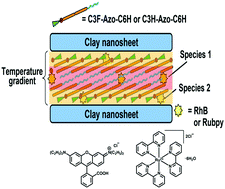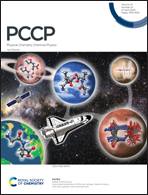Heat trapping in a nano-layered microenvironment: estimation of temperature by thermal sensing molecules
Abstract
We have previously found reversible photo-induced expansion and contraction of organic/inorganic clay hybrids, and even sliding of niobate nano-sheets at the macroscopic level of organic/inorganic niobate hybrids, induced by the molecular photo-isomerization of the polyfluoroalkylated azobenzene derivative (C3F-Azo-C6H) intercalated within the interlayer, which is viewed as an artificial muscle model unit. Based on systematic investigations of the steady state photo-isomerization and transient behavior of the reaction, we comprehended that the phenomena is caused by trapping of excess energy liberated during the isomerization, as well as the relaxation processes upon excitation of azobenzene chromophores in the interlayers of the hybrid. In this paper, quantitative estimation of transient ‘heat’ trapped in various microenvironments has been studied by each co-intercalation of temperature sensing dye molecules – rhodamine B (RhB) or tris(bipyridine)ruthenium(II) chloride (Rubpy) with C3F-Azo-C6H within clay (SSA) nano-layers. The amount of dye molecules co-intercalated was kept to trace amounts that did not alter the bi-layered structure of the hybrid. The temperature of the microenvironment surrounding the probe molecules was estimated from the emission lifetime analysis. The evidently reduced emission lifetimes in C3F-Azo-C6H/SSA and C3H-Azo-C6H/SSA hybrids in the film state, indicated the elevation of temperature of the microenvironment upon excitation of the chromophores, which demonstrated our previous hypothesis rationalizing that the high reactivity of isomerization in the hybrid film state is caused by heat trapping via multi-step dissipation of the excess energy. With the hybrid of a hydrocarbon analogue (C3H-Azo-C6H), a distinct difference in temperature gradient was found to show the crucial role of the perfluoroalkyl chain of the surfactant that traps the excess energy to retard its dissipation leading to three-dimensional morphological motion.



 Please wait while we load your content...
Please wait while we load your content...